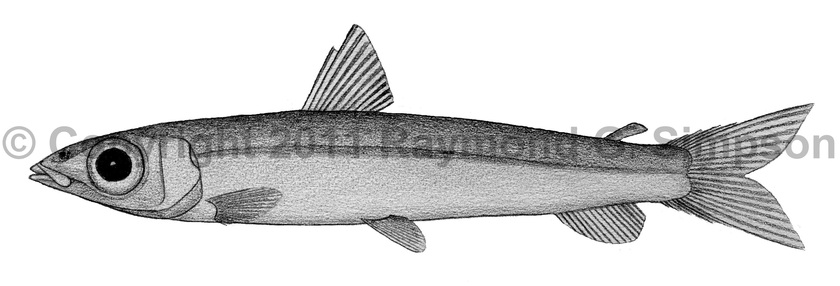
Common Name
Greater Argentine
Year Described
Ascanius, 1775
Identification
Dorsal Fin: 11-13 (usually 12-13)
Anal Fin: 13-17 (usually 15-16)
Pelvic Fin: 12-13
Pectoral Fin: 15-18
Gill Rakers: 11-15 rakers on ceratobranchiale (first arch)
Vertebrae: 64-67
Lateral Line Scales: 64-69
Branchiostegal Rays: 6
Body slender and elongate, with a small head (>3 times in SL). Eye moderate. Mouth is very small and terminal. Teeth absent on maxilla, premaxilla, dentary, and lower jaw but present on palatine, vomer, and tongue. Snout about equal to orbit diameter. Pectoral fin moderate and ventrally located; almost reaches dorsal origin. Dorsal fin base midway between snout and caudal fin base. Pelvic fin origin under the rear rays of dorsal fin, and midway between the pectoral base and anal fin. Adipose fin small and narrow and inserted over posterior rays of anal fin. Body scales covered in prickles, giving a rough texture.
Color
Dark brown above, paler below, often with an iridescent sheen dorsally. A pale to silvery stripe along side. A series of dark blotches on dorsum in some specimens. Head silvery below, dark above. Fins pale.
Size
A large species: maximum size to 700mm SL.
Habitat
Over the bottom from 140-1440m (usually 150-550m).
Range
Northwestern Atlantic: Greenland to George's Bank off Canada. The only species of W. Atlantic argentine in boreal waters.
References
Cohen, D.M. and S.P. Atsaides 1969. Additions to a revision of Argentinine fishes. United States Fish and Wildlife Service Fishery Bulletin v. 68 (no. 1): 13-36.
Kobylianskii, S.G. 2004. Argentina brasiliensis sp. nova (Argentinidae) new species of argentinid fish from the coastal subtropical waters of the southwestern Atlantic. Voprosy Ikhtiologii v. 44: 607-612. [In Russian. English translation in J. Ichthyol. v. 44 (no. 8):563-568].